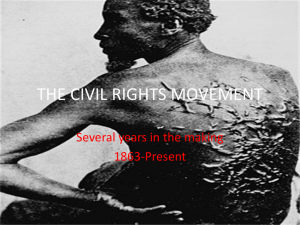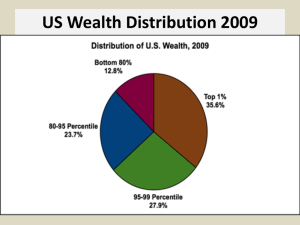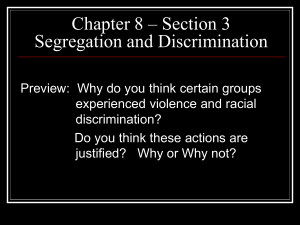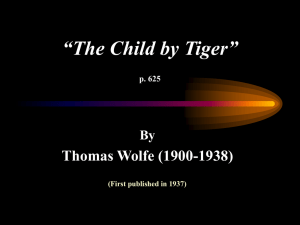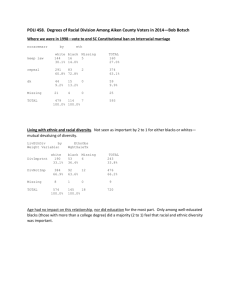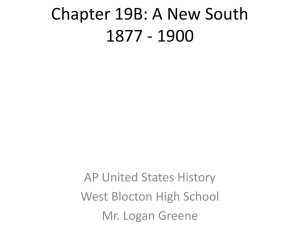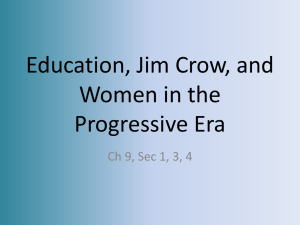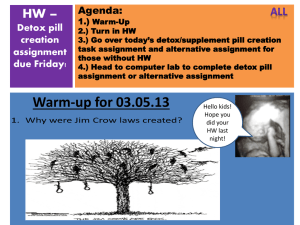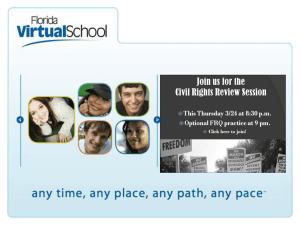ppt Ch 8, sec 3, Segregation and Discrimination
advertisement
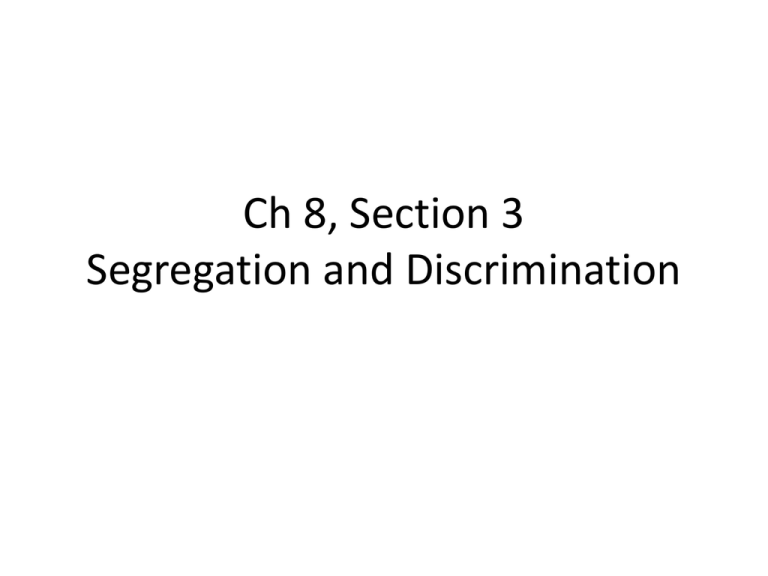
Ch 8, Section 3 Segregation and Discrimination 1. What is a lynching? • A death-by-hanging of a person without legal trial, usually at the hands of an angry mob. • Often, the lynching victim was a member of a minority group 2. During the late-1800s and early 1900s, individuals from what group of people, on many occasions, were victims of lynching? • African-Americans • From the 1890 to 1920, over 3000 Blacks were lynched in the United States • The last known lynching in the United States was in Mobile, Alabama in 1981, near McGill-Toolen Catholic School. Michael Donald, a young African-American was lynched by Ku Klux Klan members. 3. In the late 1800s, African-American journalist, Ida Wells reported persistently on what theme? • Racial Injustice against Black Americans 4. What is racial segregation? • A government-mandated and governmentenforced social system in which racial groups are required to live separately from one another. 5. What are some examples of how racial segregation manifested itself in the Southern States? • Blacks and Whites were forbidden to marry • Blacks and Whites attended separate schools • Blacks and Whites had separate public facilities such as water fountains and restrooms • Blacks and whites were forbidden to eat together in restaurants and lunch counters. 6. The 15th Amendment (passed in 1870) of the United States Constitution forbids voting restrictions on account of what? • Race • In other words, a Southern state could not merely pass a law outlawing Black voting 7. Then how did the Southern States, by the late 1800s, find a way to restrict Black voting? • By finding ways to keep Blacks from registering to vote • In short, only registered voters could vote. Unregistered voters could not vote. 8. What were three ways in which Southern states restricted Black voter registration but ensured that most whites could register to vote? • Poll Taxes • Literacy Tests • Grandfather Clauses 9. What was a poll tax? • An annual tax that had to be paid in order to vote 10. Why didn’t Blacks in the South just pay the poll tax? • Most African-Americans in the South were poor and could not afford to pay the poll tax 11. What was a literacy test? • In order to prove one’s worthiness to register to vote, one must pass a reading test in order to prove that a person could read 12. Why was the literacy test used to discriminate against potential Black voters? • First, white officials administered and graded the tests. • Usually Black test-takers were judged as having failed 13. But wait. Weren’t there many poor Southern whites who could not afford to pay the poll tax as well? • Yes, that is true 14. And…weren’t there many whites who could not read as well? • Yes, that is true 15. OK…Well, how did Southern States make it possible for most whites (whether rich or poor) to register to vote, while keeping almost all African-Americans unregistered? • Through the Grandfather Clause 16. Who benefited from the Grandfather Clause? • Potential White voters 17. What was the Grandfather Clause? • Several Southern States made laws allowing for someone to register to vote if he, his father, or his grandfather had been eligible to vote prior to January 1, 1867. • Hence, thousands of poor whites (and illiterate whites) were grandfathered in and allowed to register to vote. 18. In the South, especially Deep South States like Alabama, Mississippi, Louisiana, Georgia, and South Carolina, how long were Blacks systematically kept from registering to vote? • From the late 1800s until the passage of the Voting Rights Act of 1965 19. In States like Alabama, what happened in November 1966? • For the first time in nearly 100 years, AfricanAmericans voted in massive numbers. 20. At the same time that Southern Blacks were disenfranchised (the ability to vote being taken away), what other types of laws were passed in the South? • Jim Crow Laws 21. What are Jim Crow laws? • Laws that required the separation of Whites and Blacks in most key areas of life, namely the home, the workplace, the school, public facilities, and even the cemetery. 22. Basically “Jim Crow” was a synonym for what? • Racial Segregation 23. What did the 1896 U.S. Supreme Court decision in Plessy v. Ferguson declare to be legal? • The Court declared that “separate but equal” segregated public facilities and schools are legal. 24. When was Plessy v. Ferguson overturned by a U.S. Supreme Court? • On May 17, 1954 when, in the Brown v. Board of Education, when the Court declared that “separate but equal” is unconstitutional. 25. Thus, for nearly 60 years, what remained legal in the United States (1896-1954)? • Jim Crow Segregation 26. In addition to legally-required segregation in the South, what forms of informal discrimination did Southern Blacks face? • In general, Blacks were expected to be very subservient to Whites. • Blacks were expected to be overly polite to Whites, and never express disapproval to segregation 27. While Jim Crow Segregation was largely a southern practice, what type of Black-White relations existed outside the South in the late 1800s and early 1900s? • In the North, Midwest, and West Coast, Black Americans faced numerous forms of bigotry and discrimination, though the discrimination was less formal than in the South. 28. In 1900, what non-Southern city experienced a racially-oriented riot? • New York City 29. What is debt peonage? • A system of near-slavery in which a laborer is forced to continue providing labor to a boss in order to work off a pre-existing debt. 30. In the American Southwest, what groups were sometimes victims of debt peonage in the late 1800s and early 1900s? • Mexicans and African-Americans
